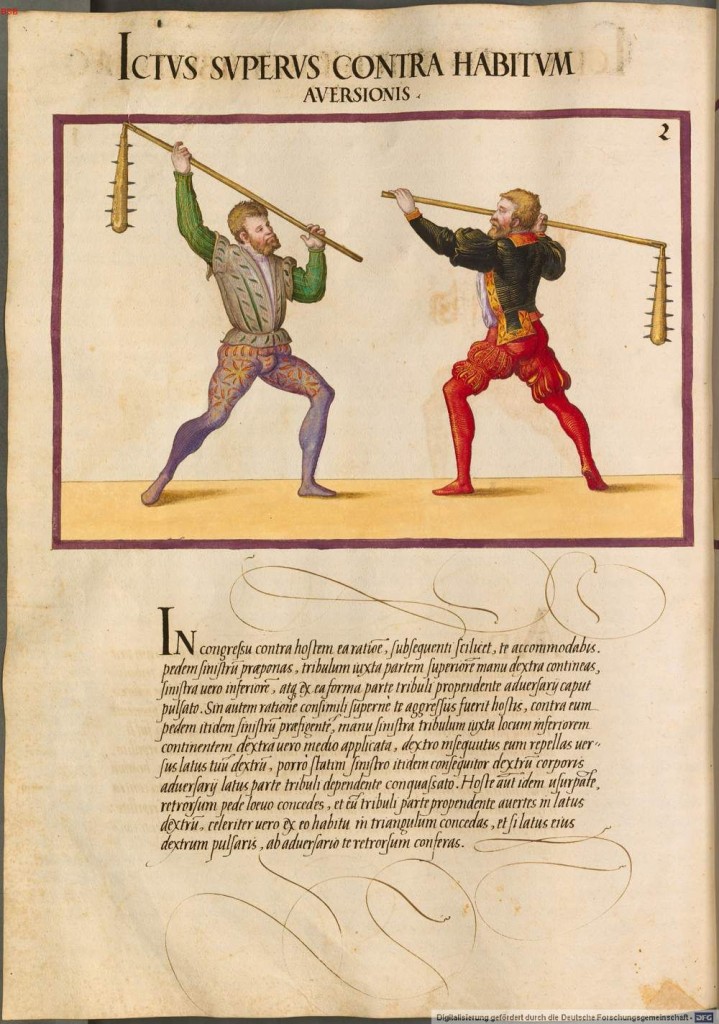Translation by Rachel Barkley
High Strike against a Deflecting Position
In the fight against your enemy by this practice, that is to say imitating what is here[1], you will adjust yourself such that you will put forward the left foot, you will hold the flail near the upper part with the right hand, the lower part with the left, and from this position strike at the head of your adversary with the hanging part of the flail[2].
If, however, the enemy will have attacked[3] you from above in a similar manner by the same reckoning[4], you fixing the left foot against the enemy in the same manner as before, holding the flail near the lower part with the left and with the right having been applied to the middle portion, you, moving forward with the right foot and turning him to your right flank, will repel him. Forthwith immediately with the left foot in the same manner as before, strike the right flank of the body of your enemy with the hanging part of the flail.
When the enemy is using the same technique, you will withdraw backwards with the left foot and you will turn him aside to the right flank with the hanging part of the flail[5]. Quickly from this position you will move in a triangle if you have struck the right side of him, you will withdraw yourself backwards from the enemy.
Notes:
[1]”Imitating what is here” appears throughout, and is intended to mean to stand as illustrated
[2]The direction of the blow is not included here, however the instruction below — “Attacked you from above in a similar manner” — indicates a vertical strike to the head.
[3]Adgressus – can also mean “move toward”
[4]”By the same reckoning” from ratione consimili, and can generally be ignored as it appears with the redundant instruction “in a similar manner” throughout
[5]Ownership of “the hanging part of the flail” is not identified. It is generally difficult to block with the head (except when held, as in Plate 1) and this may indicate a static block against Patiente’s flail head
Interpretation by Owen Townes, with assistance from Rory Cullen
Setup:
Agente&Patiente:
High guard, medium grip, left foot forward
Play:
Agente
Onside strike to Patiente’s head
Patiente
Pass forward with right foot,
slide left hand up staff,
deflecting the blow to the right side with the butt-spike,
into Scales
Pass left foot forward,
deliver an offside strike
Agente
Step back with left foot,
block to right side (see Notes above)
Step in a triangle to left side,
deliver an offside strike,
withdraw
Observations:
This has the first example of the deflection of the swinging blow with the end of the staff. It requires the movement of the left hand away from the end of the staff, the interception-from-behind of the incoming flail-head, and the deflection of it over the head and down to the ground. As with the first play, and with most of these plays, the timing is tricky, but does acquire a dance-like grace and coordination when executed correctly.
Patiente’s response with an off-side develops two additional defenses: The first, that the staff ends up between Patiente and Agente’s weapon, rather than parallel to it, and can block any short strike attempt. The second, that the buttspike can actually be brought down on top of Agente’s staff to lock it against Patiente’s leg or body and immobilize it.
Agente’s counter, stepping back, would free his flail-head. And here, again, is the issue with the un-owned flail-head of the text. The first possibility, of blocking Patiente’s flail-head, would require a static block with the staff for the block to be formed on the right side (as instructed). The second possibility, blocking with Agente’s flail-head, would require a deflection that entirely absorbs and counters Patiente’s angular momentum, which would seem even more difficult with a hinged weapon. Clearly, more experimentation is needed, and Ruarik shall be struck repeatedly!

Leave a Reply